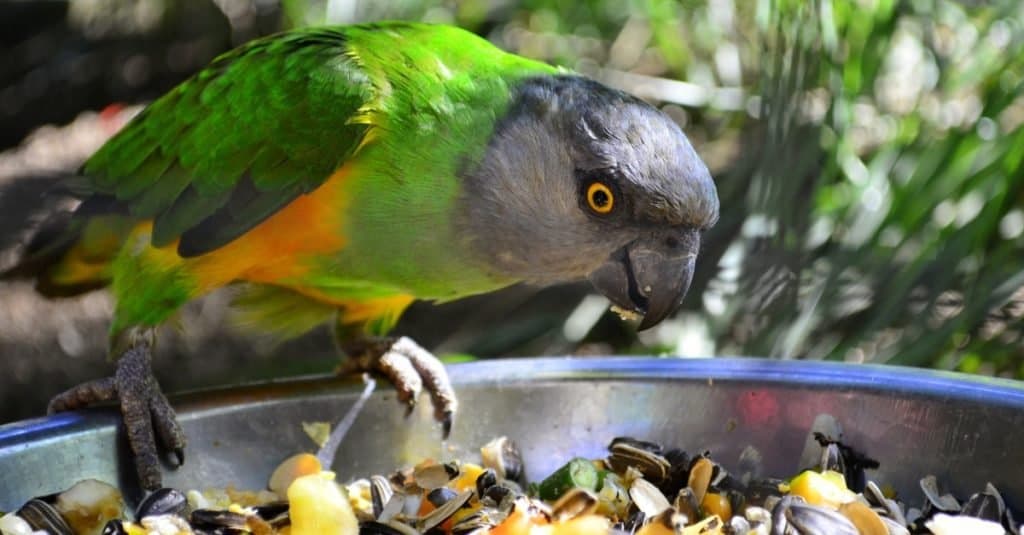Senegal Parrot
Poicephalus senegalus
As a pet, the Senegal parrot is capable of "talking" to its owner
Advertisement
Senegal Parrot Scientific Classification
- Kingdom
- Animalia
- Phylum
- Chordata
- Class
- Aves
- Order
- Psittaciformes
- Family
- Psittacidae
- Genus
- Poicephalus
- Scientific Name
- Poicephalus senegalus
Read our Complete Guide to Classification of Animals.
Senegal Parrot Conservation Status
Senegal Parrot Facts
- Fun Fact
- As a pet, the Senegal parrot is capable of "talking" to its owner
- Biggest Threat
- Habitat loss
- Most Distinctive Feature
- The bright colors and V-shaped chest markings
- Wingspan
- 6 inches
- Incubation Period
- 25-28 days
- Habitat
- Savannas and woodlands
- Predators
- Raptors, snakes, monkeys, and big cats
- Diet
- Herbivore
- Favorite Food
- Fruits, seeds, and grains
- Type
- Bird
- Common Name
- Senegal Parrot
- Number Of Species
- 1
- Location
- Western Africa
- Average Clutch Size
- 1
- Nesting Location
- Holes of tall trees
- Age of Molting
- 9-12 weeks
View all of the Senegal Parrot images!
The Senegal parrot is a gregarious and playful bird of surprising intelligence that resides in West Africa.
Their docile personality and colorful plumage make them very popular for adoption in the exotic pet trade.
This is bolstered by the ease with which they can be trained to perform tricks and commands.
3 Amazing Senegal Parrot Facts!

Senegal parrots have a beak that acts as an additional limb.
©Ondrej Prosicky/Shutterstock.com
- The beak functions as a kind of third limb that enables them to climb nimbly in trees.
- Much like a person, the Senegal parrot can favor their left or right foot.
- Senegal parrots engage in mutual feeding and preening behavior to strengthen and reinforce their social bonds.
Where to Find Them

Senegal parrot eats fruits and beans among other things in captivity.
©Eddy Fahmi/Shutterstock.com
Despite the name, the Senegal parrot is found in multiple countries throughout western Africa. It is particularly common in Nigeria, Benin, Ghana, Burkina Faso, the Ivory Coast, and, of course, Senegal itself. They prefer to live near woodlands and savannas.
Nests
The Senegal parrot nests in the holes of tall trees, especially oil palms.
Scientific Name
The scientific name of the Senegal parrot is Poicephalus senegalus. The genus of Poicephalus, which means grey head in Greek, is comprised of 10 species of African parrots, including the Cape parrot and red-fronted parrot. Senegalus is obviously a Latin version of its native country, Senegal.
There are three recognized subspecies, which vary in the colors of their chests and their location.
Besides the Senegal parrot, there are two other subspecies of this parrot:
- Mesotypus
- Versteri
Size, Appearance, and Behavior

Senegal parrots are known for this dark heads and bright bodies.
©Dennis Jacobsen/Shutterstock.com
These parrots can always be identified by their particular arrangement of bright, beautiful plumage. The dominant color on most of the body, including the wings and tail, is green. On the front of the chest, the green plumage forms a V shape with the yellow or orange plumage, which makes it look like the bird is wearing a vest. Also, like most members of its genus, this species has a gray head and beak.
The average member of this species measures about 9 to 10 inches with a wingspan of about 6 inches. There are very few consistent differences between the sexes to aid in identification. Females tend to have a smaller head and overall weight, while the V markings tend to go farther down the stomach, but these differences are not always obvious or consistent.
The Senegal parrot is a social species that seems to get along well with other birds. They are sometimes seen alone, or in pairs, or in flocks of some 10 to 20 birds. While they do not migrate for the winter, they do travel from place to place in search of new foraging opportunities. These are very noisy birds that make high-pitched screeching and whistling sounds when alarmed.
Diet

These parrots are mostly an herbivorous bird. It has sharp claws and a big beak to help them crack open seeds. However, studies have shown that Senegal parrots cannot actually see what they’re holding in their beak and claws. They have to manipulate objects without seeing them.
What does the Senegal parrot eat?

The exact diet of an individual Senegal Parrot really depends on its environment.
©Dave Montreuil/Shutterstock.com
The parrot consumes a large variety of fruits, seeds, and grains. The exact composition of their diet depends on their location and the time of the year. In captivity, they are fed a mixture of sunflower and safflower seeds, almonds, pine nuts, soybeans, chickpeas, millet, and fresh fruits and vegetables.
Predators, Threats, and Conservation Status
These parrots are currently vulnerable to predation, habitat loss, poaching, and deliberate hunting. Many farmers consider the Senegal parrot to be a bit of a pest because it has a tendency to steal their food. Poaching is less of a problem since most pet Senegal parrots are born and raised in captivity. Despite the threats they face in the wild, they are considered to be a species of least concern by the IUCN Red List.
What eats the Senegal parrot?
These parrots are preyed upon by raptors, snakes, monkeys, and big cats. The tree cover of their natural habitat offers them advantages over potential predators.
Reproduction, Young, and Molting

A pet Senegal Parrot on the leg of a person with blue jeans.
©Wit Sriun/Shutterstock.com
Very little information is actually known about the reproductive habits of wild Senegal parrots, except their annual mating season probably lasts between September and November. Like many parrots, this species probably forms long-term pair bonds with a single mate. In captivity, the female produces two to four eggs per clutch and then incubates them for about 25 to 28 days.
Born completely blind and helpless with a white down, the chicks are dependent on their parents for almost everything. The father is responsible for guarding the nest and foraging for food, while the female is responsible for incubating the eggs and sitting on the chicks. After the chicks have hatched, she too will begin foraging for food in order to feed the young.
The chicks will open their eyes about two to three weeks after hatching. Once their flight feathers have grown, they will first leave the nest at around nine weeks, but it will take another three weeks before they are fully independent. They become sexually mature at two to three years of age but don’t actually reproduce until around six to seven years. The average lifespan of these parrots is about 20 to 25 years, but it has been known to live around 40 years in captivity.
Population
There are no good population estimates for how many of these parrots survive in the wild, but numbers do appear to be stable and healthy.
View all 293 animals that start with SSenegal Parrot FAQs (Frequently Asked Questions)
Does the Senegal parrot migrate?
The Senegal parrot doesn’t have a set migratory pattern, but it does travel long distances based on the availability of fruits and seeds.
How many eggs does the Senegal parrot lay?
The Senegal parrot can lay two to four eggs at a time.
How fast does the Senegal parrot fly?
The flight speed of the Senegal parrot is not known.
What is the Senegal parrot’s wingspan?
The Senegal parrot has a wingspan of around 6 inches.
When do Senegal parrots leave the nest?
The chicks first leave the nest around nine weeks, but they aren’t fully independent until around 12 weeks.
What is a Senegal parrot?
The Senegal parrot is a colorful West African bird of medium size and weight with a gray head and green and orange plumage. It’s also easily identified by the distinctive V marking on the chest. This is a very noisy and social species that spend much of the day preening, bonding, and foraging for fruits and seeds.
Are Senegal parrots good pets?
A properly trained Senegal parrot can be a charming, docile, and playful companion with an agreeable personality, good intelligence, and bright colors. They’re among the most popular pet birds in the world. However, because they’re naturally a little skittish and wary of humans, a wild-caught Senegal will probably not make for a good pet. They need to be raised and socialized in captivity specifically for adoption by people. While they have a highly affectionate and playful personality (toys are a necessity with this species), they can also be a bit jealous of other pets. Prospective owners can find them for sale or adoption with a variety of different pet stores and breeders.
Can a Senegal parrot talk?
Yes, the Senegal parrot loves talking. It can mimic a few words of human speech and even some common noises like telephones. Fortunately, for those who don’t like the harsh screeching sounds, this bird prefers talking random words rather than making a sharp call.
Are Senegal parrots cuddly?
While the Senegal parrot does enjoy good petting, they probably should not be cuddled like cats or dogs. Use your fingers to make contact with them.
How smart are Senegal parrots?
The Senegal parrot has enough intelligence to learn some limited tricks and commands. It has the ability to play dead or jump through hoops, for instance.
Thank you for reading! Have some feedback for us? Contact the AZ Animals editorial team.
Sources
- Animal Diversity Web, Available here: https://animaldiversity.org/accounts/Poicephalus_senegalus/
- PhysOrg, Available here: https://phys.org/news/2011-04-parrots.html
- Pet Guide, Available here: https://www.petguide.com/breeds/bird/senegal-parrot/

















